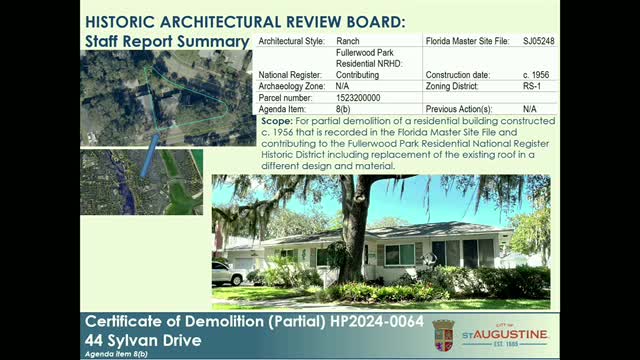Homeowner Fights for Metal Roof Amid Historic Preservation Debate
October 17, 2024 | St. Augustine, St. Johns County , Florida
This article was created by AI summarizing key points discussed. AI makes mistakes, so for full details and context, please refer to the video of the full meeting. Please report any errors so we can fix them. Report an error »

In a recent government meeting, discussions centered around the proposed replacement of an asphalt shingle roof with a 29-gauge ribbed metal panel roof for a ranch-style home at 44 Sylvan Drive. The Architectural Guidelines and Historic Preservation (AGHP) update, still pending finalization, does not currently address ranch-style houses, which has led to some contention regarding appropriate roofing materials.
The board previously indicated that ribbed metal panels were unsuitable for historic structures, suggesting instead a 5V crimp metal panel design for other architectural styles. However, a standing seam metal roof was proposed as a potentially more appropriate alternative that could maintain the historic character of the home while providing the desired aesthetic.
The homeowner expressed frustration over being denied a permit for the same roofing style that was recently approved for a neighbor's home across the street. She argued that the metal roof would enhance the beauty and character of her ranch-style home, rather than detract from it. The homeowner's appeal highlighted concerns about perceived discrimination in the permitting process, as her neighbor received approval just two months prior.
City staff clarified that the neighbor's permit had \"slipped through the cracks\" during the review process, which led to the current homeowner's application being scrutinized more closely. This discrepancy raised questions about consistency in the application of guidelines and the need for clearer communication within the permitting department.
Public comments during the meeting largely supported the homeowner's request, with several residents advocating for the practicality and aesthetic appeal of metal roofs in the area. They emphasized that metal roofing could provide long-term benefits, particularly in terms of durability and insurance considerations, given the challenges posed by Florida's climate.
As the board deliberated, members acknowledged the need to balance historical preservation with the realities of modern living, including rising insurance costs and the practicalities of roof maintenance. The discussion underscored the importance of ensuring that any approved roofing material aligns with the character of the neighborhood while accommodating homeowners' needs for durability and cost-effectiveness.
The board is expected to make a decision on the roofing proposal in the coming weeks, with a focus on finding a compromise that respects both the historical integrity of the structures and the practical needs of the residents.
The board previously indicated that ribbed metal panels were unsuitable for historic structures, suggesting instead a 5V crimp metal panel design for other architectural styles. However, a standing seam metal roof was proposed as a potentially more appropriate alternative that could maintain the historic character of the home while providing the desired aesthetic.
The homeowner expressed frustration over being denied a permit for the same roofing style that was recently approved for a neighbor's home across the street. She argued that the metal roof would enhance the beauty and character of her ranch-style home, rather than detract from it. The homeowner's appeal highlighted concerns about perceived discrimination in the permitting process, as her neighbor received approval just two months prior.
City staff clarified that the neighbor's permit had \"slipped through the cracks\" during the review process, which led to the current homeowner's application being scrutinized more closely. This discrepancy raised questions about consistency in the application of guidelines and the need for clearer communication within the permitting department.
Public comments during the meeting largely supported the homeowner's request, with several residents advocating for the practicality and aesthetic appeal of metal roofs in the area. They emphasized that metal roofing could provide long-term benefits, particularly in terms of durability and insurance considerations, given the challenges posed by Florida's climate.
As the board deliberated, members acknowledged the need to balance historical preservation with the realities of modern living, including rising insurance costs and the practicalities of roof maintenance. The discussion underscored the importance of ensuring that any approved roofing material aligns with the character of the neighborhood while accommodating homeowners' needs for durability and cost-effectiveness.
The board is expected to make a decision on the roofing proposal in the coming weeks, with a focus on finding a compromise that respects both the historical integrity of the structures and the practical needs of the residents.
View full meeting
This article is based on a recent meeting—watch the full video and explore the complete transcript for deeper insights into the discussion.
View full meeting